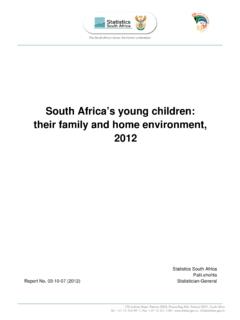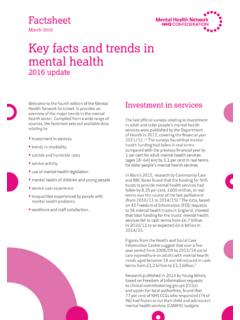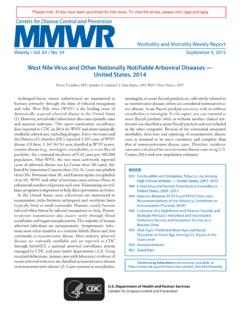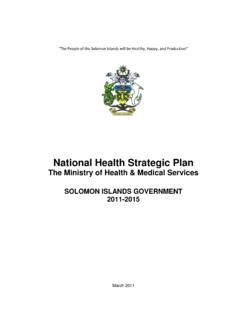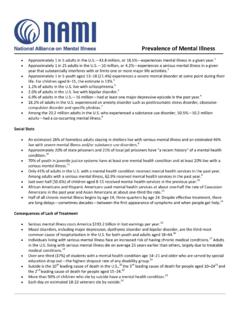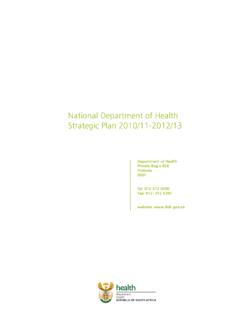Transcription of Millennium Development Goals 4 - Statistics South …
1 The South Africa I know, the home I understand ii | P a g e Millennium Development Goals 4: Reduce child mortality 2015 / Statistics South Africa Published by Statistics South Africa, Private Bag X44, Pretoria 0001 Stats SA Library Cataloguing-in-Publication (CIP) Data Millennium Development Goals 4: Reduce child mortality / Statistics South Africa, Pretoria: Statistics South Africa, 2015 32pp ISBN: 978-0-621-43865-9 The South Africa I know, the home I understand iii | P a g e TABLE OF CONTENTS LIST OF TABLES .. iv LIST OF FIGURES .. iv LIST OF ACRONYMS .. v 1. INTRODUCTION .. 4 Child mortality in the global 4 Reducing child mortality in South Africa .. 4 Newborn, infant and child health challenges in South Africa .. 7 2. TARGETS, INDICATORS AND DATA SOURCES .. 8 3. STATUS AT A GLANCE .. 9 4. MDG 4 TARGETS AND PROGRESS PER INDICATOR .. 10 Under-five mortality rate.
2 10 Infant mortality rate .. 11 Under-five and infant mortality rates (IMR) .. 12 Neonatal mortality rate .. 12 Measles immunisation coverage of children under the age of one year .. 13 Immunisation coverage of children under the age of one year .. 15 Measles outbreak 2009 2010 .. 16 Life expectancy at birth .. 16 Diarrhoea with dehydration incidence for children under the age of five years (per 1 000) .. 17 Pneumonia incidence .. 18 Prevention of mother-to-child transmission of HIV: Infant 1st PCR test positive around 6 weeks rate .. 19 5. TOWARDS SUSTAINABLE Development Goals (SDGS) .. 20 6. RECOMMENDATIONS AND CONCLUSION .. 23 Recognising district heterogeneity .. 25 Recommendations for policy and action .. 26 Conclusion .. 26 27 The South Africa I know, the home I understand iv | P a g e LIST OF TABLES Table 1: Summary of MDG 4 indicators and data sources .. 8 Table 2: Summary of Goal 4 indicators, current status and target achievability.
3 9 Table 3: Summary of Goal 4 indicators Under-five mortality rate .. 10 Table 4: Summary of Goal 4 indicators Infant mortality 11 Table 5: Summary of Goal 4 indicators Neonatal mortality rate .. 12 Table 6: Summary of Goal 4 indicators Measles immunisation coverage of children under the age of one year .. 13 Table 7: Provincial estimates of one-year-old children immunised against measles, 2003 2014 .. 14 Table 8: Provincial estimates of under-one-year-old children who received all primary vaccinations, 2003 2014 .. 15 Table 9: Summary of Goal 4 indicators Life expectancy at birth .. 16 Table 10: Trends in life expectancy at birth for males and females in South Africa .. 16 Table 11: Summary of Goal 4 indicators Diarrhoea with dehydration incidence for children under the age of five years .. 17 Table 12: Trends in diarrhoea with dehydration incidence for under-5-year-old children (per 1 000 population), 2010 2014.
4 17 Table 13: Summary of Goal 4 indicators Pneumonia incidence .. 18 Table 14: Trends in pneumonia incidence for under-5-year-old children (per 1 000 population), 2010 2014 .. 18 Table 15: Summary of Goal 4 indicators Prevention of mother-to-child transmission of HIV .. 19 Table 16: Trends in infant 1st PCR test positive around 6 weeks rate, 2010 2014 .. 19 Table 17: Relationship between MDG indicators and SDGs .. 20 Table 18: Relationship between Domesticated indicators and SDGs .. 21 Table 19: High-impact interventions to reduce neonatal mortality suggested by NaPeMMCo .. 24 LIST OF FIGURES Figure 1: Under-five mortality rate, 1998 2013 .. 10 Figure 2: Infant mortality rate, 1998-2013 .. 11 Figure 3: Under-five and infant mortality rates since 1998, and the 2015 MDG target .. 12 Figure 4: Neonatal mortality rate, 2009 2013 .. 13 Figure 5: Proportion of one-year-old children immunised against measles.
5 14 Figure 6: Proportion of under-one-year-old children who received all primary vaccinations .. 15 The South Africa I know, the home I understand v | P a g e LIST OF ACRONYMS AIDS Acquired Immune Deficiency Syndrome ART Antiretroviral Therapy ARV Antiretroviral CARMMA Campaign on Accelerated Reduction of Maternal and Child Mortality in Africa CoMMiC Committee on Morbidity and Mortality in Children Under 5 Years DHIS District Health Information System DHS Demographic and Health Survey HAART Highly Active Antiretroviral Therapy GHS General Household Survey HADCC Health Data Advisory and Coordination Committee HIV Human Immunodeficiency Virus IMR Infant Mortality Rate LMICs Low and middle-income countries MDGs Millennium Development Goals MNCWH&N Maternal, Neonatal, Child and Women s Health and Nutrition MRC Medical Research Council NaPeMMCo National Perinatal Morbidity and Mortality Committee NCCEMD National Committee on the Confidential Enquiries into Maternal Deaths NDOH National Department of Health NIDS National Indicator Dataset NMR Neonatal Mortality Rate PCR test Polymerase Chain Reaction test PMTCT Prevention of Mother-to-Child Transmission PPIP Perinatal Problem Identification Programme RMS Rapid Mortality Surveillance SDSN Sustainable Development Solutions Network SDGs Sustainable Development Goals Stats SA Statistics South Africa TB Tuberculosis U5MR Under-five Mortality Rate WHO World Health Organisation The South Africa I know, the home I understand 1 | P a g e EXECUTIVE SUMMARY Introduction The Millennium Development Goal 4 target is to reduce, by two-thirds, between 1990 and 2015 , the under-five mortality rate.
6 South Africa has made substantial progress, but not sufficient to achieve this goal. Likewise, although significant progress has been made with regard to increasing immunisation coverage, the MDG goal of achieving 95% coverage with measles vaccine in children under one year of age has not been achieved. However, since 1990, there have been substantial reductions in child mortality and the prevalence of the leading causes of child deaths, and improvements in the quality of life and life expectancy of young children in South Africa. The child survival picture at the beginning of the 1990s was stark for the majority of children who had been systematically excluded from access to quality services by apartheid policies. About 59 out of every 1 000 children would die before their fifth birthday the majority as a result of entirely avoidable or treatable causes (DHS, 1998).
7 The prevalence of the leading avoidable and/or treatable causes of child deaths diarrhoea, pneumonia and HIV was high and coverage of essential preventative interventions such as immunisation was far from universal. More than 30% of children under the age of one year were not immunised against measles, and even fewer ( ) received the full suite of primary vaccinations to protect them against preventable diseases. The picture today is very different. The majority of children in South Africa have benefited from a national drive to improve their health and well-being, which has contributed to improvements in child mortality through improved access to preventive and promotive health services. MDG target and progress The target for MDG 4 was to reduce by two-thirds, between 1990 and 2015 , the under-five mortality rate. The indicators were: To reduce under-five mortality rate to 20 per 1 000 live births To reduce infant mortality rate to 18 per 1 000 live births To increase the proportion of 1-year-old children immunised against measles to 100% The under-five mortality rate estimated from data in the country s Vital Registration System declined from 38 deaths per 1 000 live births in 1998 to per 1 000 in 2013.
8 Whilst this reduction has not been sufficiently robust to meet the 2015 goal to reduce the rate by two-thirds to 20 per 1 000, there has in recent years been a sharp acceleration in the reduction of child mortality. In 2005, South Africa was one of four countries whose rates were higher than the 1990 MDG baseline. This increase was driven in the main by a sharp decline in the health status of young children due to HIV and AIDS which became the largest cause of death in children under the age of five years. However, since 2007, when the under-five mortality rate peaked at per 1 000, a substantial decrease has been achieved. A similar pattern can be seen with regard to infant mortality. Vital registration data shows an increase from per 1 000 in 1998 to a peak of in 2007, followed by a rapid decline to per 1 000 in 2013. The neonatal mortality rate dropped from 13 per 1 000 live births in 2009 to 11 per 1 000 live births in 2013.
9 The primary causes of death in the neonatal period are preventable and include birth asphyxia, preterm birth, and infections. The leading and equally preventable causes of death among children 12 to 59 months The South Africa I know, the home I understand 2 | P a g e include malnutrition, diarrhoeal disease, lower respiratory tract infections such as pneumonia and perinatally acquired HIV infection. The proportion of one-year-old immunised against measles increased from in 2001 to in 2014. Drivers Improvements in child survival reflect both improvements in the socio-economic conditions for children, as well as improved coverage with key child survival interventions. Improvement in access to clean water and sanitation for many households and introduction of child support grants were two key interventions that played an important role in promoting nutritional, educational and health outcomes among children.
10 Likewise, improved coverage of key child survival such as immunisations, breastfeeding promotion, PMTCT, anti-retroviral therapy (ART) and treatment of common childhood illnesses (such as diarrhoea and pneumonia) using the Integrated Management of Childhood Illness (IMCI) approach, has contributed Critical factors that facilitated these improvements included: A Constitution and legislative framework that enshrine the rights of children; Introduction of policies that aimed to address child poverty and ill-health, with provision of free health services for pregnant women and children under five being of particular importance; Reorientation of the health system towards primary health care. In recent years this has included the process of primary health-care re-engineering which aims to take health services closer to people by ensuring specialist clinical oversight at district level, and through provision of primary health-care services at household level by community health workers; Establishment of Ministerial Committees that review and analyse newborn and child deaths, provide oversight and make recommendations for improving newborn and child health; The Development and adoption of the Maternal, Neonatal, Child and Women s Health and Nutrition Strategic Plan (MNCWH&N) 2012 2016; Strengthened systems for surveillance and data collection, which aimed to monitor and analyse data and use the results to inform a process of on-going improvement.









